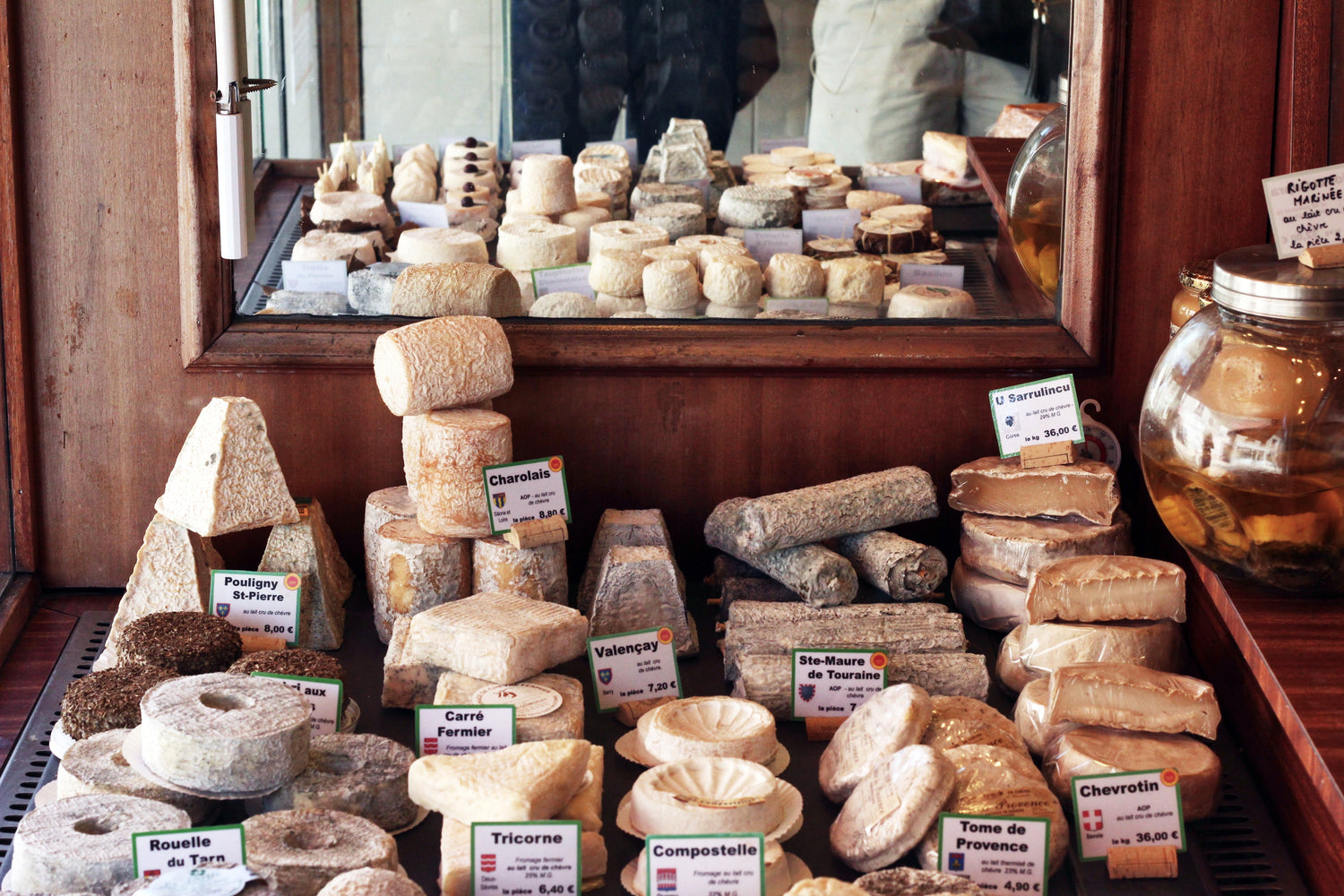A huge part of the French lifestyle is appreciating wonderful food and drink with friends and family. A classic element of this is enjoying the wide variety of French cheeses available. The Couleur Nature French cheese guide explains the different styles, how to prepare and eat them, some interesting French cheese facts, and what some of the terminology means. We’ll also include some examples of our favorite cheese varieties from around the world.

Types of French cheese
So just how many types of cheese are there in France? With at least 350 varieties, it can make understanding the labels and jargon somewhat complicated! We’ve broken them down into 7 broad categories to help you navigate the cheese aisle with ease.

Soft cheeses
These cheeses, made from cow’s milk, are aged for about one month and have doughy white surfaces. They are available with natural rind, or with the rind washed away to prevent mold.
Brie and Camembert are examples of the most popular French cheeses in the ‘soft’ category, with a natural rind, while Muenster and Livarot are ‘washed rind’ varieties.

Semi-soft cheeses
Semi-soft cheese may be made from both pasteurized and raw milk. Great for snacking or desserts, semi-soft cheeses can also be frozen and thawed without losing much flavor, however be aware that some can become crumbly.
Bel Paese is a mild Italian semi-soft cheese that works well on pizza or pasta dishes. An alternative is Esrom which melts wonderfully, and is great in casserole dishes.
Hard cheeses
As they age, cheeses usually become firmer and more pungent, so hard cheeses are often packed with flavor. They have a longer shelf life and are often used for grating onto dishes.
Mimolette is a hard and nutty cheese. With its brilliant orange color it looks great on a platter. It changes flavor as it ages, from parmesan when younger to more of a hazelnut flavor when it’s properly aged. Abbaye de Belloc has a dense texture with a flavor comparable to caramelized brown sugar.

Semi-hard cheeses
Some key characteristics of semi-hard cheese is that they are great for sandwiches and can be cooked without becoming oily. They are often pressed during the production process to remove moisture and as with hard cheese, become firmer and more pungent with time.
Abondance has a nutty flavor and is a great cheese for melting. Cheddar is an example of a semi-hard cheese that nearly everybody has heard of. It’s a versatile cheese and can be mild, medium or sharp.
Bleu cheeses
Blue cheese was a happy accident - originally stored in moist caves with favourable conditions for mold to grow. Modern blue cheeses have mold cultures introduced to give the final product a blue-veined or spotted appearance, plus a distinctive strong smell. Many manufacturers still use caves to age the cheese.
Roquefort is a classic example of a blue-veined cheese which is rather well-known. Moist and crumbly, it has a rich creamy and sharp flavor and is often used in salads.
Goat’s cheese
Created from goat’s milk, this gives an earthy and sometimes barnyard flavor to the final cheese. (The author’s partner kept goats on a smallholding during her youth, and to this day cannot consume milk or cheese from goats - the smell brings to mind the aroma of the animal itself!) The cheese is generally soft and can also be mixed with cow’s milk.
China makes Rubing which resembles Indian paneer, but France is one of the world’s great producers of cheese from goat’s milk, with examples including Chabis and Clochette.
Fresh cheeses
Also known as unripened cheese, this is made by curdling cow, sheep or goat milk, then draining off the whey. The remaining curds are fashioned into cheese. More bland than other cheeses discussed here, they are often used as components in other flavorings. They are often higher in moisture and highly perishable. Unlike blue cheese, if there is mold on a fresh cheese, it is not edible.
Fromage frais is probably the most well-known example of cheese of this genre. Creamy white, made with whole or skimmed milk and cream, it is used as a savory appetizer or dessert.
How and where cheese is made

As well as understanding the different types of cheese in terms of flavor and texture, it’s important to know how and where the cheese was produced so you know what to expect.
Fermier
This means the milk production and cheese making has all taken place on the same farm.
Artisanal
This is similar to fermier, but the cheese maker may add milk from other farms.
Industriel
Cheese labelled in this way has been produced in an industrial factory, with milk from multiple sources.
Cooperative
This type of cheese is a collaboration between milk producers and cheese makers in the same geographical area, but not on the same farm.
How to eat cheese (and some French cheese facts)
- Store cheese towards the bottom of your refrigerator where the temperature remains more even.
- Like red wine, enjoy cheese at room temperature to bring out the flavors. Take it out of the fridge an hour before you plan to eat it.
- Remember that harder cheeses have a longer shelf life than the softer, moist ones.
- If you have mold on your cheese (mold that is not meant to be there!) cut it off, with a half inch margin around it.
- Rinds - cut them off hard cheeses (such as cheddar) but they are edible on the softer cheeses like Camembert or Brie.
- Go easy on the bread & crackers - they can interfere with the cheese's flavor. To really appreciate the taste, try eating it on its own.

If you’re considering a cheese platter, make sure you have a good set of cheese knives and a cheese board. Provide toothpicks for your guests to transfer the cheese from the cheese board to their plates. Couleur Nature has a wide range of table accessories and linen to make your setting look beautiful when you’re entertaining friends and family, including a beautiful marble cheese board - either an elegant round variety, or a rectangular cheese board with a paddle, plus matching cheese knives to complete the set.

The best way to enjoy cheese from a platter is to eat the cheese from the mildest to the strongest to avoid overwhelming your tastebuds early on and missing out on the subtleties of some of the milder ones. A good rule of thumb is that generally, creamy cheeses are milder than the hard ones.
With such a wide range of cheeses available, the important thing is that there’s bound to be one for you. Our French cheese list barely scratches the surface of what is available. The most pungent blue cheese might not be to your taste, but don’t feel pressured if it’s not what you enjoy. Trust your own preference and eat the types of cheese that you love! In a future article we will be looking at pairing wines with different types of cheese, so check back soon to learn more.



